A Blood Sugar Log PDF is a printable tool designed to help individuals track and monitor their blood glucose levels effectively. It provides a structured format for recording daily readings, enabling better diabetes management and insight into glucose patterns. This log is essential for anyone needing to maintain balanced blood sugar levels, offering a simple yet effective way to stay organized and informed about their health.
1.1 What is a Blood Sugar Log?
A blood sugar log is a structured document used to record and monitor blood glucose levels over time. Typically formatted as a table, it includes columns for date, time, meal type, blood sugar readings, insulin doses, and notes. Available as a downloadable PDF, it allows individuals to track their glucose levels conveniently. The log is customizable to suit different needs, such as type 1 or type 2 diabetes management. By documenting daily readings, users can identify patterns, understand how food and activity impact their levels, and make informed decisions to maintain balanced blood sugar. It serves as a vital tool for effective diabetes care and management.
1.2 Importance of Tracking Blood Sugar Levels
Tracking blood sugar levels is crucial for understanding how your body responds to food, medication, and activity. It helps identify patterns, such as high or low glucose trends, enabling timely adjustments to your diabetes management plan. Regular monitoring improves awareness of how daily choices impact your health, fostering better control and reducing the risk of complications. By maintaining a consistent record, you can share valuable insights with your healthcare provider, leading to more informed decisions. This practice is essential for achieving and maintaining balanced blood sugar levels, ultimately enhancing overall health and well-being for individuals with diabetes.
1.3 Who Can Benefit from Using a Blood Sugar Log?
Individuals with type 1 or type 2 diabetes, as well as pre-diabetics, can significantly benefit from using a blood sugar log. It is also useful for those monitoring their glucose levels to maintain balanced health. The log helps track patterns, enabling personalized management of diet, medication, and activity. Healthcare providers can use the data to adjust treatment plans, making it a valuable tool for collaborative care. Additionally, it empowers individuals to take an active role in their health, fostering awareness and control over their blood sugar levels, which is essential for long-term diabetes management and overall well-being.
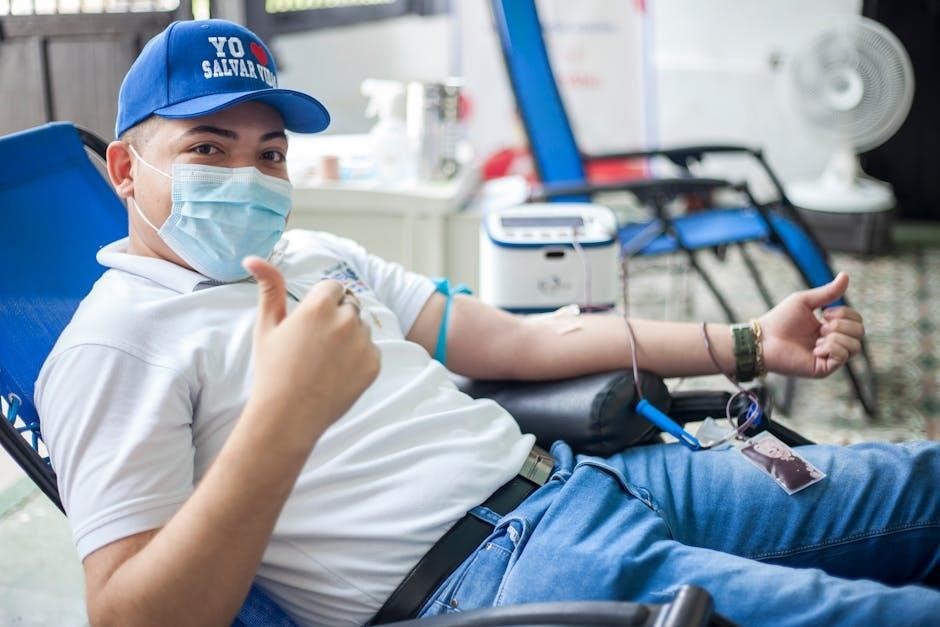
Why Use a Blood Sugar Log PDF?
A Blood Sugar Log PDF helps track glucose levels, identify patterns, and manage diabetes effectively, providing a clear record for informed decision-making with healthcare providers.
2.1 Advantages of Printable Blood Sugar Logs
Printable blood sugar logs offer numerous benefits, including portability, ease of use, and cost-effectiveness. They provide a structured format for tracking glucose levels, meals, and medications, making it easier to identify patterns and manage diabetes. These logs are accessible to everyone, regardless of digital proficiency, and can be easily shared with healthcare providers for better decision-making. Additionally, they allow for customization to suit individual needs, such as adding notes on food intake or physical activity, enhancing personalized care and promoting long-term health management effectively.
2.2 How a Blood Sugar Log Helps in Diabetes Management
A blood sugar log is a vital tool for effective diabetes management. By tracking glucose levels, individuals can identify patterns and trends, helping to prevent hyperglycemia and hypoglycemia. It allows for monitoring the impact of meals, medications, and physical activity on blood sugar levels. This data enables informed adjustments to treatment plans, such as insulin dosages or diet modifications. Regular logging also helps set realistic goals and fosters collaboration with healthcare providers, ensuring personalized and optimal diabetes care. Over time, consistent use of a blood sugar log improves overall health outcomes and enhances quality of life for those managing diabetes.

Types of Blood Sugar Logs Available
Blood sugar logs come in various formats, including daily, weekly, and monthly templates. These logs are designed to suit different tracking needs, offering flexibility for short-term or long-term monitoring.
3.1 Daily Blood Sugar Log Templates
Daily blood sugar log templates are designed for individuals who need to track their glucose levels frequently throughout the day. These logs typically include time slots for breakfast, lunch, dinner, and bedtime, allowing users to monitor their blood sugar fluctuations closely. They often feature sections for recording meals, insulin doses, and physical activity, providing a comprehensive overview of daily habits and their impact on glucose levels. By using a daily log, individuals can identify patterns, manage medications effectively, and maintain consistency in their diabetes care. These templates are available as printable PDFs, making them easy to use and customize for personal needs.
3.2 Weekly Blood Sugar Log Sheets
Weekly blood sugar log sheets provide a broader view of glucose levels over a seven-day period, helping users identify trends and patterns. These logs often include columns for breakfast, lunch, dinner, and bedtime readings, as well as space for notes on insulin doses, meals, and physical activity. Weekly logs are ideal for individuals who prefer less frequent tracking but still want to monitor their glucose levels consistently. They are also useful for reviewing progress with healthcare providers and adjusting diabetes management plans accordingly. Printable weekly sheets are convenient, portable, and easy to use, making them a popular choice for long-term tracking and analysis.
3.3 Monthly Blood Sugar Tracking Logs
Monthly blood sugar tracking logs offer a comprehensive overview of glucose levels over an extended period. These logs provide detailed insights into long-term trends, helping users and healthcare providers identify seasonal patterns or lifestyle impacts. With space for daily entries, these logs are ideal for monitoring consistency and progress in diabetes management. They often include sections for notes on medications, diet, and physical activity, allowing for a holistic approach to health tracking. Monthly logs are particularly useful for reviewing long-term goals and adjusting treatment plans, making them a valuable tool for sustained health management and personalized care strategies.
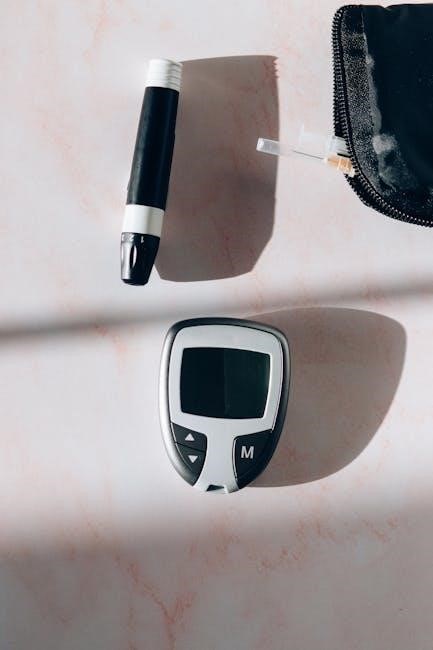
Key Features of a Blood Sugar Log PDF
A Blood Sugar Log PDF typically includes time slots for tracking meals, space for recording glucose levels, and additional fields for notes, insulin doses, and food intake.
4.1 Time Slots for Tracking (Breakfast, Lunch, Dinner, etc.)
A key feature of a Blood Sugar Log PDF is the inclusion of specific time slots for tracking glucose levels at meals and snacks. These slots are typically labeled for breakfast, lunch, dinner, and bedtime, with additional spaces for pre- and post-meal readings; This structured format ensures consistency and accuracy in monitoring blood sugar levels throughout the day. By organizing data by meal times, individuals can easily identify patterns and make informed decisions about their diet and medication; This feature is especially useful for managing daily glucose fluctuations and maintaining a clear record for healthcare provider reviews.
4.2 Space for Recording Blood Glucose Levels
A Blood Sugar Log PDF includes dedicated spaces for recording blood glucose levels at specific times of the day. These sections are clearly labeled, allowing users to enter numerical values and units of measurement. The log provides ample room for documenting readings before and after meals, as well as at bedtime. This feature ensures that all glucose data is captured accurately and remains easily accessible for review. By maintaining a clear and organized record, individuals can better understand their glucose trends and make informed decisions to manage their diabetes effectively. This structured approach simplifies tracking and supports long-term health goals.
4.3 Additional Fields for Notes and Insights
Blood Sugar Log PDFs often include extra fields for notes and insights, allowing users to document factors influencing their glucose levels. These sections can be used to record details about food intake, physical activity, insulin doses, and any symptoms experienced. By capturing this information, individuals can identify patterns and correlations between their lifestyle choices and blood sugar fluctuations. These notes also serve as valuable discussions points during consultations with healthcare providers, enabling more personalized and effective diabetes management strategies. This feature enhances the log’s utility, making it a comprehensive tool for tracking and understanding glucose trends over time. Such insights are crucial for maintaining optimal health.

How to Use a Blood Sugar Log Effectively
Using a Blood Sugar Log PDF involves consistent tracking of glucose levels, noting patterns, and analyzing data to make informed decisions. This helps in managing diabetes effectively and achieving better health outcomes.
5.1 When to Test Blood Sugar Levels
Testing blood sugar levels at specific times is crucial for effective tracking; Common testing times include upon waking, before meals, after eating, at bedtime, and before snacks. Consistency is key to identifying patterns and trends in glucose levels. For individuals with diabetes, testing before and after meals helps monitor how food affects blood sugar. Additionally, testing at bedtime ensures safety overnight. Regular testing at the same times each day provides a clear picture of glucose fluctuations, aiding in better decision-making and diabetes management; Always consult a healthcare provider to determine the best testing schedule for your specific needs.
5.2 How to Record Data Accurately
To ensure accurate recording, use a glucose meter and log your levels immediately after testing. Note the time of each reading and whether it was taken before or after meals. Include additional details like food consumed, physical activity, or medications taken, as these factors influence blood sugar levels. Be consistent with units of measurement and avoid guessing values. Review your log regularly to catch any errors or missed entries. Accurate data helps identify patterns and supports informed decisions for diabetes management. Clear and precise recording is essential for maximizing the benefits of a blood sugar log.
5.3 Tips for Maintaining Consistency
Establish a daily routine for recording blood sugar levels, ideally at the same times each day. Use reminders or alarms to stay on track. Always carry your log and glucose meter together. Record readings immediately after testing to avoid forgetting. Be thorough by including notes about meals, portion sizes, physical activity, and any medications taken. Review your log weekly to identify trends and areas for improvement. Consistency helps in making informed decisions and achieving better blood sugar control. Over time, this habit will become second nature, ensuring accurate and reliable data for effective diabetes management.
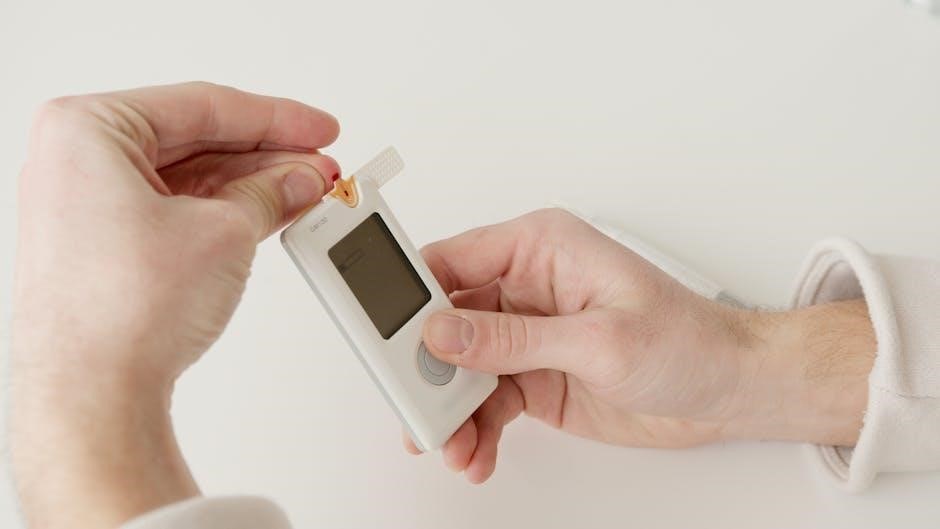
Customizing Your Blood Sugar Log
Customizing your Blood Sugar Log lets you add personalized columns, design your own template, and use digital tools for editing. Tailor it to your needs for better tracking and management.
6.1 Adding Personalized Columns (e.g., Insulin, Food, Activity)
Enhance your Blood Sugar Log by adding personalized columns for insulin doses, food intake, and physical activity. These additions provide a comprehensive view of factors influencing blood glucose levels. Tracking insulin helps manage dosage adjustments, while noting meals and snacks reveals dietary impacts. Recording activity levels highlights how exercise affects glucose fluctuations. By incorporating these elements, you gain deeper insights into daily patterns, enabling more informed decisions for effective diabetes management. Customize the log to include any additional metrics relevant to your health journey, ensuring it serves as a tailored tool for optimal blood sugar control.
6.2 Designing Your Own Template
Designing your own Blood Sugar Log template allows for a personalized approach to tracking glucose levels. Start with a standard template and modify it to suit your needs, adding or removing sections as required. Use tools like Microsoft Word or Google Sheets to create a custom layout. Include fields for blood glucose readings, insulin doses, food intake, and physical activity to gain a holistic view of your health. Ensure the design is clear and easy to use, making it simpler to maintain consistency. Tailor the template to align with your specific health goals, providing a flexible and adaptable tool for effective blood sugar management.
6.3 Using Digital Tools for Editing
Digital tools offer flexibility and convenience when editing Blood Sugar Log templates. Use software like Adobe Acrobat or Google Sheets to customize PDF templates, ensuring they meet your specific needs. These tools allow you to add notes, adjust layouts, and incorporate additional features like charts or graphs. Digital editing also enables easy sharing with healthcare providers for better collaboration. Additionally, many templates are available in editable formats, making it simple to personalize and print. Utilize these tools to streamline your tracking process and maintain accurate, organized records of your blood sugar levels for effective diabetes management.

Benefits of Printable Blood Sugar Logs
Printable Blood Sugar Logs offer a portable, cost-effective, and eco-friendly way to monitor glucose levels, ensuring easy access and organization for effective diabetes management anytime, anywhere.
7.1 Portability and Ease of Use
Printable Blood Sugar Logs are designed for convenience, offering a lightweight and portable solution for tracking glucose levels. They can be easily carried in a bag or notebook, allowing users to record readings anywhere, anytime. The simplicity of these logs ensures that individuals with busy lifestyles can maintain consistent tracking without hassle. Their straightforward format makes them user-friendly, enabling quick data entry and easy reference. This portability and ease of use make printable logs an ideal choice for managing diabetes effectively, regardless of location or circumstances.
7.2 Cost-Effective Solution
Printable Blood Sugar Logs are a cost-effective solution for managing diabetes. They are often available for free online, eliminating the need for expensive digital tools or apps. Users can print as many copies as needed, reducing waste and saving money. This accessibility makes them an ideal option for individuals on a budget or those who prefer a no-frills approach to tracking their glucose levels. By providing a low-cost, reusable resource, printable logs offer a practical and economical way to maintain consistent blood sugar monitoring without financial strain.
7.3 Environmentally Friendly Option
Printable Blood Sugar Logs are an environmentally friendly option for managing diabetes. By allowing users to print only what is needed, they reduce unnecessary paper waste. Many templates are designed to be concise, ensuring minimal ink usage. Additionally, digital versions can be edited and stored electronically, further minimizing the environmental impact. This eco-conscious approach makes printable logs a sustainable choice for individuals who prefer traditional tracking methods while being mindful of their carbon footprint. Opting for digital storage or reusable formats also aligns with green practices, making them a responsible option for long-term health management.
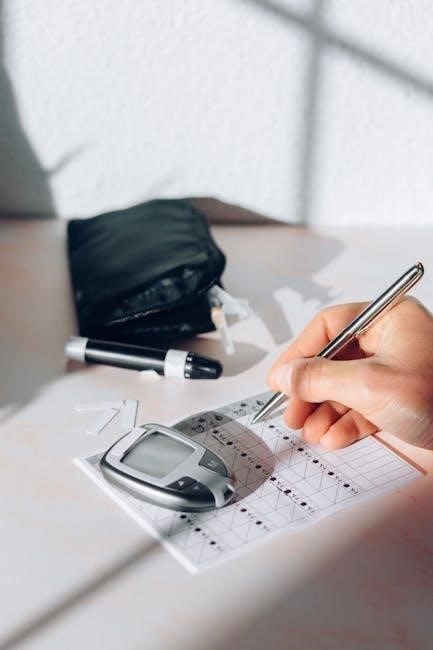
How to Download and Print a Blood Sugar Log PDF
Easily download and print Blood Sugar Log PDFs by clicking the image, saving the file, and printing copies to track glucose levels over time;
8.1 Steps to Access Free Templates Online
To access free Blood Sugar Log templates, search online for “free blood sugar log PDF.” Choose a template that suits your needs, such as daily or weekly formats. Click on the image or download button to save the PDF to your device. Open the file and print it on standard paper. Many templates are editable in Word or Pages for customization before printing. These logs allow you to track blood sugar levels, insulin doses, and meals, providing a clear overview of your glucose patterns. They are available in various formats, including PDF, PNG, and JPG, making them easy to use and share with healthcare providers.
8.2 Choosing the Right Format for Your Needs
Selecting the appropriate Blood Sugar Log format ensures effective tracking and suits your personal preferences. Consider whether you need daily, weekly, or monthly logs, depending on your testing frequency. Choose templates with customizable fields to include additional information like insulin doses or food intake. Ensure the format is easy to read and fill out, with clear time slots and space for notes. Some templates are editable in Word or Pages, allowing personalization. Opt for formats that align with your diabetes management goals, such as tracking patterns or sharing data with healthcare providers. This ensures the log meets your specific needs and enhances its usefulness in managing blood sugar levels effectively.
8.3 Printing Tips for Optimal Results
To ensure your Blood Sugar Log PDF prints clearly, select the correct paper size and orientation. Use high-quality paper for better readability. Choose the “Fit to Page” option to avoid scaling issues. Print in high-resolution settings for crisp text and grids; For best results, use a laser printer or high-quality inkjet printer. Ensure the template is downloaded in the correct format (PDF, PNG, or JPG) and that all fields are visible. Test-print on scrap paper first to verify alignment and clarity. This ensures your log is professional, easy to use, and meets your tracking needs effectively.
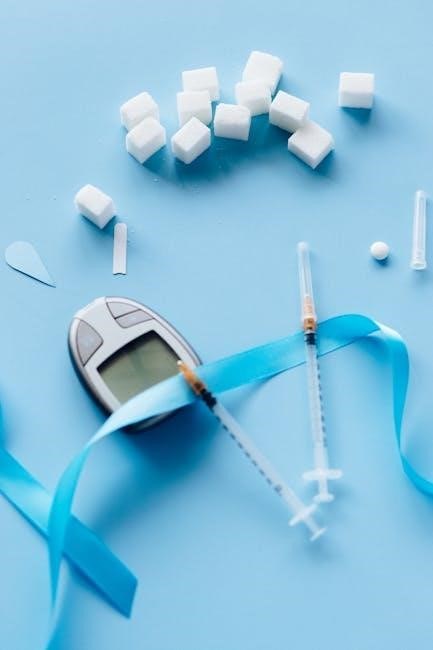
Interpreting Your Blood Sugar Log
Interpreting your Blood Sugar Log helps identify patterns in glucose levels, set realistic goals, and discuss results with healthcare providers for informed diabetes care decisions.
9.1 Identifying Patterns in Blood Glucose Levels
Identifying patterns in blood glucose levels helps individuals understand fluctuations in their readings over time. By regularly analyzing their Blood Sugar Log, users can detect trends, such as consistently high levels after specific meals or low levels at certain times of the day. This insight allows for adjustments in diet, exercise, or medication to maintain balanced glucose levels. Recognizing these patterns is crucial for effective diabetes management, as it enables individuals to anticipate and mitigate potential spikes or dips, ultimately improving their overall health and reducing complications.
9.2 Setting Realistic Goals for Blood Sugar Management
Setting realistic goals for blood sugar management is essential for effective diabetes care. By analyzing data from your Blood Sugar Log, you can identify achievable targets for your glucose levels. These goals should be specific, measurable, and aligned with your health needs. For example, aiming to reduce post-meal spikes or maintaining consistent fasting levels. Working with your healthcare provider ensures these goals are tailored to your lifestyle and medical requirements. Realistic goals help maintain motivation and promote long-term success in managing blood sugar levels, ultimately improving overall health and reducing the risk of diabetes-related complications.
9.3 Discussing Results with Your Healthcare Provider
Sharing your Blood Sugar Log with your healthcare provider is crucial for effective diabetes management. This tool provides a clear overview of your glucose trends, helping identify patterns and areas for improvement. Your provider can use this data to adjust your treatment plan, such as modifying medication, diet, or exercise routines. Regular discussions ensure personalized care and address any concerns promptly. By collaborating with your healthcare team, you can make informed decisions and achieve better blood sugar control, ultimately improving your overall health and reducing the risk of complications. Open communication is key to optimizing your diabetes management strategy.
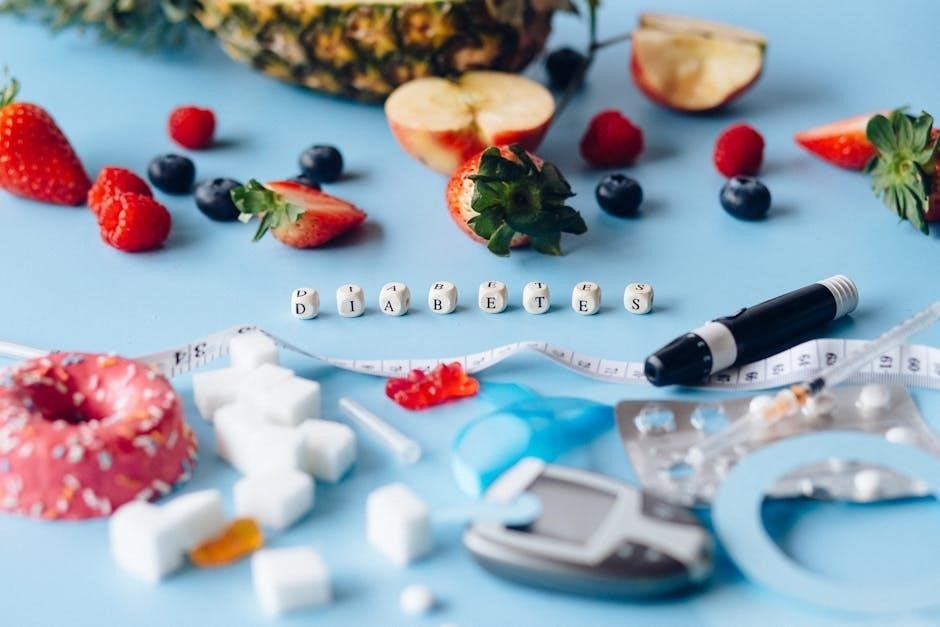
Tools and Resources for Blood Sugar Tracking
Utilize mobile apps, spreadsheets, and websites for digital tracking, or opt for printable blood sugar log PDFs. These tools help manage and analyze glucose data effectively for better health outcomes.
10.1 Recommended Websites for Free Templates
Several websites offer free blood sugar log PDF templates, such as the American Diabetes Association and CDC’s Diabetes Compass. These platforms provide customizable and printable logs tailored for daily, weekly, or monthly tracking. Many sites also offer templates in editable formats like Microsoft Word or Mac Pages, allowing users to personalize their logs further. Additionally, resources like diabetes.org and yourdiabetescompass;cdc.gov include comprehensive tools to help users manage their glucose levels effectively. These templates are designed to be user-friendly and adaptable, ensuring they meet individual needs for diabetes management.
10.2 Apps for Digital Blood Sugar Tracking
For those preferring digital solutions, apps like MySugr, Glucose Buddy, and Blood Sugar Tracker offer comprehensive tools to monitor blood glucose levels. These apps allow users to log readings, set reminders, and generate detailed reports. Many apps also integrate with wearable devices, enabling seamless data syncing. Additionally, they provide insights into how diet, exercise, and medication impact blood sugar levels. Digital tracking apps are particularly useful for individuals who prefer convenience and want to access their data on-the-go. They complement traditional PDF logs by offering real-time analysis and personalized recommendations to enhance diabetes management.
10.3 Additional Diabetes Management Resources
Beyond blood sugar logs, numerous resources are available to support diabetes management. Websites like the CDC’s Diabetes Compass and the American Diabetes Association offer extensive guides, meal planners, and educational materials. Mobile apps such as MyFitnessPal and Lose It! assist with nutrition tracking, while platforms like Diabetes Connect provide community support. Additionally, many healthcare providers offer downloadable resources, including carb counting guides and medication reminders. These tools empower individuals to take control of their diabetes care, fostering a holistic approach to managing the condition effectively and making informed lifestyle choices. Utilizing these resources can significantly enhance overall diabetes management strategies.
Consistently using a Blood Sugar Log PDF fosters awareness and control over glucose levels, empowering individuals to manage diabetes effectively and make informed health decisions with confidence.
11.1 The Impact of Consistent Blood Sugar Tracking
Consistent blood sugar tracking is crucial for effective diabetes management, offering insights into glucose trends and patterns. By regularly monitoring levels, individuals can identify fluctuations, understand how diet and activity affect their health, and make informed decisions. This data enables the setting of realistic goals and facilitates meaningful discussions with healthcare providers. Over time, consistent tracking empowers individuals to take control of their condition, leading to improved blood sugar control and enhanced overall well-being. It is a simple yet powerful tool for achieving long-term health benefits.
11.2 Encouragement to Start Using a Blood Sugar Log
Starting to use a blood sugar log is a proactive step toward better health management. It empowers individuals to take control of their diabetes care and makes tracking glucose levels simple and organized. With free, printable templates widely available, getting started is easy and accessible. By consistently recording blood sugar levels, users can identify patterns, make informed decisions, and communicate effectively with healthcare providers. Encouraging oneself to begin this habit fosters accountability and leads to improved health outcomes. Visit trusted websites like CDC’s Diabetes Compass for reliable templates and guidance to support your journey.
11.3 Final Tips for Successful Diabetes Management
For effective diabetes management, prioritize consistency in tracking blood sugar levels using a log. Regularly review your entries to identify trends and adjust your diet or medication as needed. Stay organized by customizing your log to include meals, insulin doses, and physical activity. Leverage free templates from trusted sources like the CDC Diabetes Compass to streamline your tracking process. By maintaining a detailed and accurate record, you empower yourself and your healthcare team to make informed decisions, fostering better glucose control and overall well-being.
